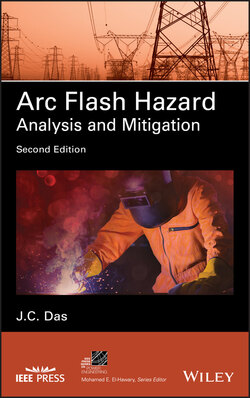Читать книгу Arc Flash Hazard Analysis and Mitigation - J. C. Das - Страница 43
1.15 REDUCING ARC FLASH HAZARD
ОглавлениеElectrical arc flash hazard cannot be reduced to HRC zero even in small distribution systems. Electrical power systems vary in complexity—an industrial power system may have a number of in-plant generators in cogeneration mode with utility tie and consume 200 MW of power with hundreds of unit substations and extensive power distribution at medium voltages and low voltage levels, containing motors of thousands of horsepower, a single motor exceeding ratings of 25,000 hp or more and multiple utility interconnections. Conversely, a system with a one or two 480 V transformers of 1000 KVA will also be classified as industrial systems. Thus, it is difficult to lay down all the general rules for reducing arc flash hazard in power systems.
This book contains many study cases and examples, and it is recommended that a reader may do a first reading of the book to grasp an overall picture, followed by a subsequent study. The following common parameters can be stated for arc flash hazard reduction:
1 Reduce the short-circuit currents by proper system designs and load distribution. The arcing current is a function of the bolted three-phase current, and its reduction in the first place will reduce the arc flash hazard (see Chapters 5 and 6).
2 Manipulate the protection and protective device coordination without sacrificing selectivity. Generally, it can be said that reducing the short-circuit currents in an existing system will be practically impossible, but the protective relaying can be manipulated to reduce the arcing time. See Chapters 7 through 14, which discuss differential protections, arc flash detection protection, zone selective interlocking, use of maintenance mode switches to alter the protective relay settings, application of modern multifunction microprocessor-based protective relays, and coordination on instantaneous basis with current limiting devices.
3 Consider high resistance grounding systems—though the IEEE equations give a lower incident energy for solidly grounded systems, as compared with resistance grounded or high resistance grounded systems; because it takes a safe stance that single line-to-ground faults will quickly escalate to three-phase faults; yet approximately 70% of the faults start as single line-to-ground faults. The single line-to-ground faults in solidly grounded systems can be even higher than the three-phase faults. See Chapter 4.
The IEEE Guide equations reveal that the incident energy and the resulting arc flash hazard for a certain equipment type depends only upon these three parameters as stated above. Yet there are many aspects to be considered for a workers safety, discussed above and in the chapters to follow:
Remote operation, avoiding human machine interface to avoid human errors during routine operation
Remote racking of circuit breakers
Proper system designs and maintenance. See 10 bulleted items describing design features and maintenance in Chapter 2.
Proper worker training and documentation of safety procedures, and safety awareness
Proper testing, online monitoring, and diagnostics of the systems
Proper record keeping
Applications of new equipments and technologies for arc flash reduction
Proper rigorous arc flash hazard studies, labeling, and use of appropriate PPE
Adherence to safety codes, standards, and recommended practices
Remote operation, avoiding human machine interface to avoid human errors during routine operation
Remote racking of circuit breakers
